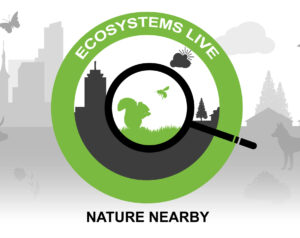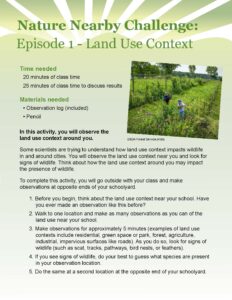Past Program
Ecosystems LIVE: Nature Nearby
-

SHARE
During this program in the FSNatureLIVE series, we’ll learn about how the environment and human actions impact animals as well as how you can investigate what animals live near you.
Join us this February for four episodes:
• Episode 1: Mammals — 2/7/2025 runtime 12:18
• Episode 2: Insects — 2/14/2025 runtime 11:57
• Episode 3: Investigating Animals — 2/21/2025 runtime 12:40
All our videos and live streams will be available on the Natural Inquirer YouTube channel: ![]() @naturalinquirerprogram
@naturalinquirerprogram
Learn About:
- The Nature Around You
- The Environment and Human Interactions
- What Animals Live Near You
SHARE
Episodes
-
 This program in the FSNatureLIVE series will focus on the nature that is all around us. In this 12-minute episode, we will investigate how the environment and human actions affect...
This program in the FSNatureLIVE series will focus on the nature that is all around us. In this 12-minute episode, we will investigate how the environment and human actions affect...Ecosystems LIVE: Nature Nearby Episode 1
This program in the FSNatureLIVE series will focus on the nature that is all around us. In this 12-minute episode, we will investigate how the environment and human actions affect... -
 This program in the FSNatureLIVE will focus on the nature that is all around us. In this episode, we will investigate how the environment and human actions affect different insects....
This program in the FSNatureLIVE will focus on the nature that is all around us. In this episode, we will investigate how the environment and human actions affect different insects....Ecosystems LIVE: Nature Nearby Episode 2
This program in the FSNatureLIVE will focus on the nature that is all around us. In this episode, we will investigate how the environment and human actions affect different insects.... -
 This program in the FSNatureLIVE will focus on the nature that is all around us. In this episode, we will investigate how to find out what animals may live near...
This program in the FSNatureLIVE will focus on the nature that is all around us. In this episode, we will investigate how to find out what animals may live near...Ecosystems LIVE: Nature Nearby Episode 3
This program in the FSNatureLIVE will focus on the nature that is all around us. In this episode, we will investigate how to find out what animals may live near...
Trailers
-

Ecosystems LIVE: Nature Nearby — Official Trailer

Learn more about our upcoming program Ecosystems LIVE: Nature Nearby!

Ecosystems LIVE: Nature Nearby — Teaser Trailer

A very brief video on our newest LIVE program!
-
 Use this graphic organizer to guide students through Episode 1 of Ecosystems LIVE. Topics include biotic and abiotic factors of ecosystems, the difference between biodiversity and species abundance, and a...
Use this graphic organizer to guide students through Episode 1 of Ecosystems LIVE. Topics include biotic and abiotic factors of ecosystems, the difference between biodiversity and species abundance, and a...Ecosystems LIVE Episode 1 – Graphic Organizer – Human Impacts on Mammals
Use this graphic organizer to guide students through Episode 1 of Ecosystems LIVE. Topics include biotic and abiotic factors of ecosystems, the difference between biodiversity and species abundance, and a... -
 After watching episode 1 of Ecosystems LIVE about human impacts on mammals, you can try this Nature Nearby Challenge. In this activity, you will observe the land use context around...
After watching episode 1 of Ecosystems LIVE about human impacts on mammals, you can try this Nature Nearby Challenge. In this activity, you will observe the land use context around...Ecosystems LIVE Episode 1 – Activity – Land Use Context
After watching episode 1 of Ecosystems LIVE about human impacts on mammals, you can try this Nature Nearby Challenge. In this activity, you will observe the land use context around... -
 Use this graphic organizer to guide students through Episode 2 of Ecosystems LIVE. Topics include biotic and abiotic factors that affect insects and arachnids in their ecosystems, the benefits insects...
Use this graphic organizer to guide students through Episode 2 of Ecosystems LIVE. Topics include biotic and abiotic factors that affect insects and arachnids in their ecosystems, the benefits insects...Ecosystems LIVE Episode 2 – Graphic Organizer – Human Impacts on Insects
Use this graphic organizer to guide students through Episode 2 of Ecosystems LIVE. Topics include biotic and abiotic factors that affect insects and arachnids in their ecosystems, the benefits insects... -
 After watching episode 2 of Ecosystems LIVE about human impacts on insects, you can try this Nature Nearby Challenge. In this activity, you’ll simulate the act of pollination using snack...
After watching episode 2 of Ecosystems LIVE about human impacts on insects, you can try this Nature Nearby Challenge. In this activity, you’ll simulate the act of pollination using snack...Ecosystems LIVE Episode 2 – Activity – Pollination
After watching episode 2 of Ecosystems LIVE about human impacts on insects, you can try this Nature Nearby Challenge. In this activity, you’ll simulate the act of pollination using snack... -
 Use this graphic organizer to guide students through Episode 3 of Ecosystems LIVE. Topics include safety tips for investigating animals, using our senses to identify animals, animal tracks and scat,...
Use this graphic organizer to guide students through Episode 3 of Ecosystems LIVE. Topics include safety tips for investigating animals, using our senses to identify animals, animal tracks and scat,...Ecosystems LIVE Episode 3 – Graphic Organizer – Investigating Animals
Use this graphic organizer to guide students through Episode 3 of Ecosystems LIVE. Topics include safety tips for investigating animals, using our senses to identify animals, animal tracks and scat,... -
 After watching episode 3 of Ecosystems LIVE about investigating the animals that live near you, try this Nature Nearby Challenge. In this activity, you will use your senses to make...
After watching episode 3 of Ecosystems LIVE about investigating the animals that live near you, try this Nature Nearby Challenge. In this activity, you will use your senses to make...Ecosystems LIVE Episode 3 – Activity – Animal Investigations
After watching episode 3 of Ecosystems LIVE about investigating the animals that live near you, try this Nature Nearby Challenge. In this activity, you will use your senses to make...
Glossary
View All Glossary-

Susannah Lerman
My favorite experience is discovering exciting birds and insects in our backyards and neighborhood parks. I spend a lot of time exploring local habitats and talking with neighbors about the...View Profile -

Aaron Grade
My favorite science experience was when I trained college and high school volunteers to measure birds for a scientific study. Scientists use a special kind of net called a “mist...View Profile -

Farrah Masoumi
Farrah Masoumi is a conservation education program manager for the U.S. Forest Service. She partners with the Natural Inquirer on many FS Nature LIVE programs.View Profile -

Tonee Davis
View Profile -

Liz Burke
View Profile
Standards addressed in this Virtual Learning Adventure:
Next Generation Science Standards
The Next Generation Science Standards (NGSS) are a set of K-12 science education standards emphasizing inquiry-based learning, real-world applications, and integrating engineering practices, aiming to deepen understanding of science while promoting critical thinking and problem-solving skills.
- ESS3.C-M1Human activities have significantly altered the biosphere, sometimes damaging or destroying natural habitats and causing the extinction of other species. But changes to Earth’s environments can have different impacts (negative and positive) for different living things.
- LS2.A-M1Organisms, and populations of organisms, are dependent on their environmental interactions both with other living things and with nonliving factors.
- LS2.A-M4Similarly, predatory interactions may reduce the number of organisms or eliminate whole populations of organisms. Mutually beneficial interactions, in contrast, may become so interdependent that each organism requires the other for survival. Although the species involved in these competitive, predatory, and mutually beneficial interactions vary across ecosystems, the patterns of interactions of organisms with their environments, both living and nonliving, are shared.
- LS2.C-M1Ecosystems are dynamic in nature; their characteristics can vary over time. Disruptions to any physical or biological component of an ecosystem can lead to shifts in all its populations.
Social Studies Standards
Social Studies Standards are educational guidelines outlining the essential knowledge, skills, and concepts students should learn in subjects such as history, geography, civics, and economics, aiming to provide a comprehensive understanding of societal structures, historical events, and global perspectives.
- People, Places, and Environments
- Science, Technology, and Society
- Time, Continuity, and Change












